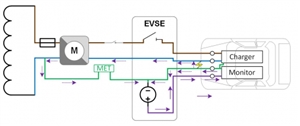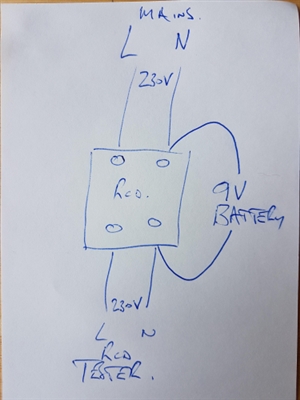
DC + 18ms and DC - 7.5ms. So all passed with flying colours, trip times about 20ms at 30 mA all round. 10 MA of DC changed the AC 180 to 21 mA and DC+ to 12 mA
Are these ramp tests, results in mA RMS at time to trip, or times in milliseconds ?
Either could make sense in the context but imply subtly different things.
In any case I am heartened that you too see the blinding current is comparable to the trip current , as that backs up my observations - so 20mA may pull a 30mA RCD slightly off beam on a 30mA test, but it will still fire at a fault current of 100mA, and still needs a jammer comparable to the higher test current to blind it.
The failure to trip on a supply with a PSSC of <16 amps, tells me this is an electronic RCD and internally there is a fairly chonky actuator coil pulled in by a power transistor or triac, not a delicate hairspring loaded mechanical balance. The actuator current needed to fire ones of this sort can be several amps, and the internals are not as fine or as fussy as the traditional passives.
Please take care not to burger what looks like a decent PSU, - note that at the moment of opening, you do not know if the L or N arc extinguishes first, so there is a risk of a mains voltage or part of it appearing on the PSU for a short time if the contact with the PSU accross is the one that opens first.
Also, even with the volts low, you are shunting the N sense coil with the unknown output impedance of the PSU - which should be quite low and may give some imbalance to begin with.
If there is a known series resistance, say 100 ohms, (even an old kettle element or something would do) then the fault current if subjected to mains is limited, and the current share between coil and PSU is very much in favour of the coil at a few milli-ohm versus the PSU and resistor combo.
I have also spoofed an LNE with a fake E and a very local NE bond for such tests, from an L and N only - so upstream RCDs are not affected. But of course only after double checking polarity is right.
Perhaps I too need to take a pic, but my set up is, shall we say, rather more agricultural, and I'd want to tidy up first, or folk will chitter about the exposed live bits.
Sparkingchip:
I had the diagram that Graham Kenyon posted in another discussion in mind.
https://communities.theiet.org/discussions/viewtopic/1037/25732?post_id=138070#p138070
Andy B.

davezawadi:
Yes Andy, but that will put the short circuit ability (which may be an amp if its a good battery) through the RCD and we are working on milli-amps of DC! A 1k resistor also in the battery circuit will give 9mA etc.
gkenyon:
davezawadi:
Yes Andy, but that will put the short circuit ability (which may be an amp if its a good battery) through the RCD and we are working on milli-amps of DC! A 1k resistor also in the battery circuit will give 9mA etc.Agreed - that's effectively what we have with EV charging equipment pilot, but the source is 12 V not 9 V.
How much is shared with the Neutral depends on the resistances of the conductors upstream back to the point of common coupling.
Therefore in a TT system, the risk is less than a TN system, and TN-S lower DC current is likely to be shared than in a TN-C-S (PME) installation.
Good morning,
Here’s a brief explanation of what the CCID box does and how it controls the charging. We have no information as to what type of RCD is fitted to the CCID.
The box on the cable is not the charger, it is a control and interruption device that switches the current to the on board charger (OBC) which is mounted in the car, on and off. The CCID initially outputs a 12VDC supply via a switch onto pin 3 of the EVSE (Electric Vehicle Supply Equipment) Connector whenever the charge lead is plugged in to a 240VAC power supply. This indicates the EVSE is ready, but not connected to a vehicle.
When the EVSE connector is connected to a vehicle, a resistor in the OBC pulls the voltage on pin 3 down to 9V. This indicates to the CCID that it is connected to a vehicle. At this point, the CCID activates a switch to start sending the PWM Pilot signal out on Pin 3. The pilot signal tells the OBC how much current it can draw. In the UK this will be 10A.
Once the OBC registers the Pilot signal, it switches on another switch. This connects a resistor into the circuit which pulls the voltage down to 6V. This tells the CCID to commence charging and the CCID will then switch on the RCD to allow mains supply to the charge lead.
When the battery has reached full charge the OBC will turn off the relevant switches which puts the pilot signal back up to 9v which tells the CCID to switch off the RCD.
I hope this helps.
Kind regards,
We're about to take you to the IET registration website. Don't worry though, you'll be sent straight back to the community after completing the registration.
Continue to the IET registration site